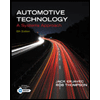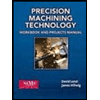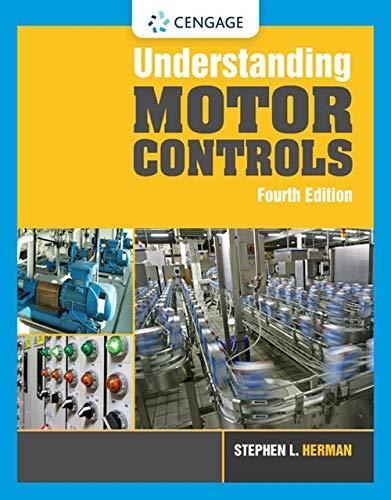
Automotive Technology
7th Edition
ISBN: 9781337794213
Author: ERJAVEC, Jack.
Publisher: Cengage,
expand_more
expand_more
format_list_bulleted
Concept explainers
Textbook Question
Chapter 24, Problem 1SA
Describe the difference between an open- and a closed-loop operation.
Expert Solution & Answer
To determine
The difference between an open- and a closed-loop operation.
Answer to Problem 1SA
Closed-loop operations work on the principle of feedback. The output from the current operation is used to modify the input for the next operation. The open-loop operation works only on the input. There is no feedback for this open-loop operations.
Explanation of Solution
Some of the significant differences between an open- and a closed-loop operation are as follows:
| Closed-loop operation | Open-loop operation |
| Its basis is the output of the current operation. The feedback from the current output is used to modify the input. | Does not have any feedback system. It completely works on the input. |
| Less stable. | Mostly stables. |
| Overall cost is high. | Overall cost is low. |
| Easy to calibrate. | Difficult to calibrate. |
| Examples are refrigerator, Air conditioner, toaster, etc. | Examples are automatic washing machine, Traffic light, TV remote, etc. |
| The structure of closed-loop operations are complex and so they are difficult to be implemented. | The structure of open-loop operations are simple and so they are easy to be implemented. |
Conclusion:
Closed-loop operation works on the feedback i.e. its basis is the output whereas open-loop operation is completely based on the input.
Want to see more full solutions like this?
Subscribe now to access step-by-step solutions to millions of textbook problems written by subject matter experts!
Students have asked these similar questions
For the following MATLAB code, I need to answer a few questions. Can you identify the curves as elliptic functions? Which curves reflect the sn, cn, and dn functions?From the curves, determine the maximum amplitudes and the period corresponding toeach angular velocity component.
clc;
clear all;
I = [500; 125; 425];
w = [0.2; 0.1; 0.2];
rev = 0:0.01:10;
C = eye(3);
% Using ode45 to integrate the KDE and DDE
options = odeset('RelTol',1e-9,'AbsTol',1e-9);
result = ode45(@K_DDE, rev, [w; I; C(:)], options);
v = result.x;
% Extracting information from the ode45 solver
w = result.y(1:3, :);
C_ode = reshape(result.y(7:end, :), [3,3,length(v)]);
plot(v, w)
xlabel('rev')
ylabel('w (rad/s)')
legend('w1', 'w2', 'w3')
% Functions
function dwCdt = K_DDE(~, w_IC)
% Extracting the initial condtions to a variable
w = w_IC(1:3);
I = w_IC(4:6);
C = reshape(w_IC(7:end), [3, 3]);
I1 = I(1);
I2 = I(2);
I3 = I(3);
K1 = -(I3-I2)/I1;
K2 = -(I1-I3)/I2;
K3 = -(I2-I1)/I3;
%…
please show a drawing/image and explain how to properly do the question. thanks
For the four-bar- linkage shown in the following figure. BC=68mm, CD=100mm, AD=120mm. Determine the range of AB to
make it a crank-rocker mechanism.
B
D
Chapter 24 Solutions
Automotive Technology
Ch. 24 - Describe the difference between an open- and a...Ch. 24 - Explain the use and importance of system strategy...Ch. 24 - Describe an OBD II warm-up cycle.Ch. 24 - Explain the trip and drive cycle in an OBD II...Ch. 24 - Describe how engine misfire is detected in an OBD...Ch. 24 - Describe the purpose of having both upstream and...Ch. 24 - Briefly describe the monitors in an OBD II system.Ch. 24 - Type B engine misfires are excessive if the...Ch. 24 - The monitor system checks the action of the can...Ch. 24 - The monitor system has a(n) and test to check the...
Ch. 24 - The fuel monitor checks fuel trim and fuel trim.Ch. 24 - Which sensor is used for misfire monitoring on OBD...Ch. 24 - Which of the following statements is not true?...Ch. 24 - A computer is capable of doing all of the...Ch. 24 - Which of the following memory circuits is used to...Ch. 24 - Technician A says that the oxygen sensor provides...Ch. 24 - While discussing OBD II systems: Technician A says...Ch. 24 - While discussing the catalyst efficiency monitor:...Ch. 24 - While discussing monitoring systems: Technician A...Ch. 24 - While discussing the comprehensive monitoring...Ch. 24 - Prob. 6ASRQCh. 24 - While discussing diagnostic procedures: Technician...Ch. 24 - Technician A says that the enable criteria are the...Ch. 24 - While discussing PCM monitor tests: Technician A...Ch. 24 - While discussing the misfire monitor: Technician A...
Knowledge Booster
Learn more about
Need a deep-dive on the concept behind this application? Look no further. Learn more about this topic, mechanical-engineering and related others by exploring similar questions and additional content below.Similar questions
- all of those 4 fi 1)Draw kinematic diagram: 2)DOF: 3)type/name of mechanism 4)evolution:arrow_forward7.4 Impeller viscometer The rheology of a Penicillium chrysogenum broth is examined using an impeller viscometer. The density of the cell suspension is approximately 1000 kg m³. Samples of broth are stirred under laminar conditions using a Rushton turbine of diameter 4 cm in a glass beaker of diameter 15 cm. The average shear rate generated by the impeller is greater than the stirrer speed by a factor of about 10.2. When the stirrer shaft is attached to a device for measuring torque and rotational speed, the following results are recorded. Stirrer speed (s¹) Torque (Nm) 0.185 3.57 × 10-6 0.163 3.45 × 10-6 0.126 3.31 x 10-6 0.111 3.20×10-6 Can the rheology be described using a power-law model? If so, evaluate K and n.arrow_forward(read image)arrow_forward
- (read image) Answer Providedarrow_forwardThis is part B Part A's question and answer was find moment of inertia (Ix = 3.90×10^5) and radius of gyration (kx = 21.861) Determine the centroid ( x & y ) of the I-section, Calculate the moment of inertia of the section about itscentroidal x & y axes. How or why is this result different fromthe result of a previous problem?arrow_forwardDetermine by direct integration the moment of inertia of theshaded area of figure with respect to the y axis shownarrow_forward
- Consider the feedback controlled blending system shown below, which is designed to keep theoutlet concentration constant despite potential variations in the stream 1 composition. The density of all streamsis 920 kg/m3. At the nominal steady state, the flow rates of streams 1 and 2 are 950 and 425 kg/min,respectively, the liquid level in the tank is 1.3 m, the incoming mass fractions are x1 = 0.27, x2 = 0.54. Noticethe overflow line, indicating that the liquid level remains constant (i.e. any change in total inlet flow ratetranslates immediately to the same change in the outlet flow rate). You may assume the stream 1 flowrate andthe stream 2 composition are both constant. Use minutes as the time unit throughout this problem. Identify any controlled variable(s) (CVs), manipulated variable(s) (MVs),and disturbance variable(s) (DVs) in this problem. For each, explain how you know that’show it is classified.CVs: ___________, MVs: _____________, DVs: ______________ b) Draw a block diagram…arrow_forwardA heat transfer experiment is conducted on two identical spheres which are initially at the same temperature. The spheres are cooled by placing them in a channel. The fluid velocity in the channel is non-uniform, having a profile as shown. Which sphere cools off more rapidly? Explain. V 1arrow_forwardMy ID# 016948724 last 2 ID# 24 Last 3 ID# 724 Please help to find the correct answer for this problem using my ID# first write le line of action and then help me to find the forces {fx= , fy= mz= and for the last find the moment of inertial about the show x and y axes please show how to solve step by steparrow_forward
- My ID# 016948724 last 2 ID# 24 Last 3 ID# 724 Please help to find the correct answer for this problem using my ID# first write le line of action and then help me to find the forces and the tension {fx= , fy= mz=arrow_forwardMy ID# 016948724 last 2 ID# 24 Last 3 ID# 724 Please help to find the correct answer for this problem using my ID# first write le line of action and then help me to find the forces {fx= , fy= mz=arrow_forwardmy ID is 016948724 Last 2 ID# 24 Last 3 ID# 724 please help me to solve this problem step by step show me how to solve first wirte the line actions and then find the forces {fx=, fy=, mz= and for the last step find the support reactions and find forcesarrow_forward
arrow_back_ios
SEE MORE QUESTIONS
arrow_forward_ios
Recommended textbooks for you
 Automotive Technology: A Systems Approach (MindTa...Mechanical EngineeringISBN:9781133612315Author:Jack Erjavec, Rob ThompsonPublisher:Cengage Learning
Automotive Technology: A Systems Approach (MindTa...Mechanical EngineeringISBN:9781133612315Author:Jack Erjavec, Rob ThompsonPublisher:Cengage Learning Precision Machining Technology (MindTap Course Li...Mechanical EngineeringISBN:9781285444543Author:Peter J. Hoffman, Eric S. Hopewell, Brian JanesPublisher:Cengage Learning
Precision Machining Technology (MindTap Course Li...Mechanical EngineeringISBN:9781285444543Author:Peter J. Hoffman, Eric S. Hopewell, Brian JanesPublisher:Cengage Learning Understanding Motor ControlsMechanical EngineeringISBN:9781337798686Author:Stephen L. HermanPublisher:Delmar Cengage Learning
Understanding Motor ControlsMechanical EngineeringISBN:9781337798686Author:Stephen L. HermanPublisher:Delmar Cengage Learning

Automotive Technology: A Systems Approach (MindTa...
Mechanical Engineering
ISBN:9781133612315
Author:Jack Erjavec, Rob Thompson
Publisher:Cengage Learning

Precision Machining Technology (MindTap Course Li...
Mechanical Engineering
ISBN:9781285444543
Author:Peter J. Hoffman, Eric S. Hopewell, Brian Janes
Publisher:Cengage Learning

Understanding Motor Controls
Mechanical Engineering
ISBN:9781337798686
Author:Stephen L. Herman
Publisher:Delmar Cengage Learning
The Robot Revolution: The New Age of Manufacturing | Moving Upstream; Author: Wall Street Journal;https://www.youtube.com/watch?v=HX6M4QunVmA;License: Standard Youtube License